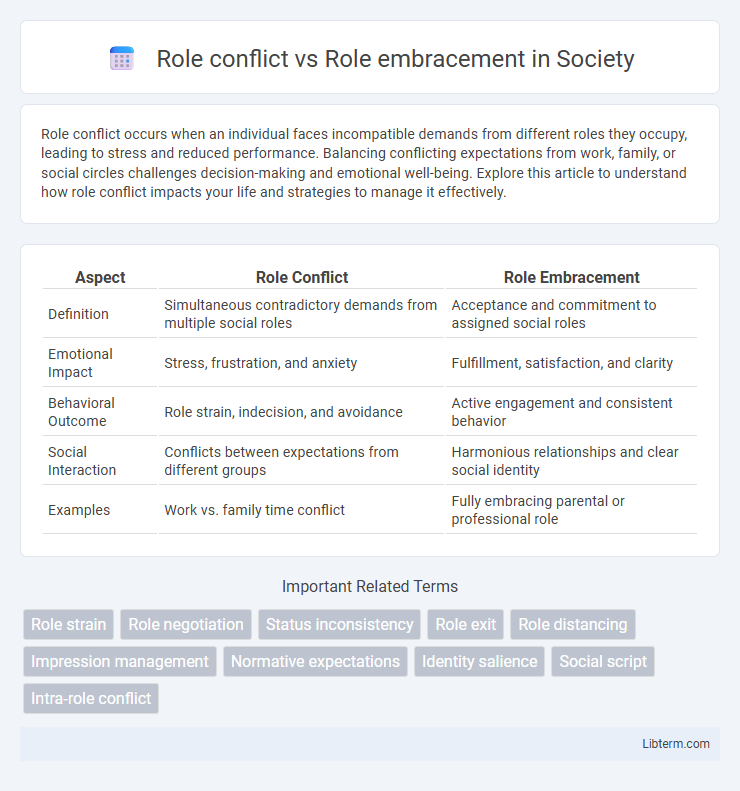Role conflict occurs when an individual faces incompatible demands from different roles they occupy, leading to stress and reduced performance. Balancing conflicting expectations from work, family, or social circles challenges decision-making and emotional well-being. Explore this article to understand how role conflict impacts your life and strategies to manage it effectively.
Table of Comparison
| Aspect | Role Conflict | Role Embracement |
|---|---|---|
| Definition | Simultaneous contradictory demands from multiple social roles | Acceptance and commitment to assigned social roles |
| Emotional Impact | Stress, frustration, and anxiety | Fulfillment, satisfaction, and clarity |
| Behavioral Outcome | Role strain, indecision, and avoidance | Active engagement and consistent behavior |
| Social Interaction | Conflicts between expectations from different groups | Harmonious relationships and clear social identity |
| Examples | Work vs. family time conflict | Fully embracing parental or professional role |
Understanding Role Conflict
Role conflict arises when incompatible demands from multiple social roles create stress and hinder effective performance, often seen in work-family challenges or leadership-team dynamics. Understanding role conflict involves recognizing the sources of tension between competing expectations and identifying strategies to manage or resolve these conflicts to maintain psychological well-being. Addressing role conflict improves role clarity and supports smoother role embracement, leading to enhanced identity integration and overall satisfaction.
Defining Role Embracement
Role embracement involves fully accepting and integrating assigned responsibilities, leading to enhanced job satisfaction and performance. Unlike role conflict, where individuals experience tension due to incompatible expectations, role embracement promotes clarity and commitment by aligning personal values with role demands. This positive alignment fosters motivation, reduces stress, and strengthens organizational identification.
Key Differences Between Role Conflict and Role Embracement
Role conflict occurs when an individual faces incompatible demands from multiple roles, leading to stress and reduced performance, whereas role embracement involves accepting and integrating roles harmoniously to enhance satisfaction and productivity. In role conflict, competing expectations create tension and hinder effective role fulfillment, while role embracement fosters a positive attitude toward role responsibilities and promotes balance. Key differences include the presence of psychological strain in role conflict versus psychological acceptance and commitment in role embracement.
Causes of Role Conflict
Role conflict arises when incompatible expectations from multiple roles create tension and stress, often caused by ambiguous role definitions, overlapping responsibilities, and competing demands from work and family domains. Unclear communication or lack of support from supervisors and colleagues further exacerbates the conflict by increasing uncertainty and workload pressure. In contrast, role embracement occurs when individuals accept and integrate their role expectations, leading to effective role management and reduced psychological strain.
Factors Influencing Role Embracement
Role embracement is influenced by factors such as individual identity alignment, organizational support, and role clarity, which enhance commitment and performance. Psychological empowerment and social support from peers and supervisors reinforce positive acceptance of role expectations. Cultural norms and personal values also significantly shape how individuals internalize and embrace their assigned roles.
Psychological Impacts of Role Conflict
Role conflict arises when an individual faces incompatible demands from different roles, leading to psychological stress, anxiety, and decreased job satisfaction. This tension can cause emotional exhaustion, impaired cognitive function, and reduced overall well-being. In contrast, role embracement fosters role clarity and acceptance, promoting psychological resilience and enhanced mental health.
Benefits of Role Embracement
Role embracement enhances individual productivity by fostering a strong sense of ownership and accountability within assigned responsibilities. Embracing roles promotes adaptability and resilience, allowing individuals to navigate complex situations with confidence and clarity. This approach cultivates positive interpersonal relationships and organizational cohesion by aligning personal values with role expectations.
Strategies for Managing Role Conflict
Strategies for managing role conflict include setting clear boundaries between professional and personal responsibilities, prioritizing tasks based on urgency and importance, and fostering open communication with supervisors and colleagues to realign expectations. Time management techniques, such as scheduling specific periods for distinct roles, enhance focus and reduce overlap that triggers conflict. Developing emotional intelligence helps individuals recognize stress signals and adapt coping mechanisms, promoting effective role embracement.
Enhancing Role Embracement in Daily Life
Enhancing role embracement in daily life involves recognizing and integrating multiple social identities harmoniously, which reduces stress caused by role conflict. Strategies such as clear communication, setting realistic expectations, and prioritizing self-awareness empower individuals to navigate overlapping responsibilities effectively. Emphasizing role embracement fosters resilience and satisfaction by aligning personal values with social roles, promoting psychological well-being.
Role Conflict vs Role Embracement: Implications for Personal Growth
Role conflict arises when an individual experiences incompatible demands between different roles, often leading to stress and hindered personal development, whereas role embracement involves fully accepting and integrating multiple roles, fostering resilience and self-awareness. The navigation of role conflict can prompt critical reflection and boundary-setting, essential skills for personal growth, while role embracement enhances identity coherence and emotional stability. Understanding and managing the tension between role conflict and role embracement play a crucial role in psychological well-being and overall self-improvement.
Role conflict Infographic

 libterm.com
libterm.com